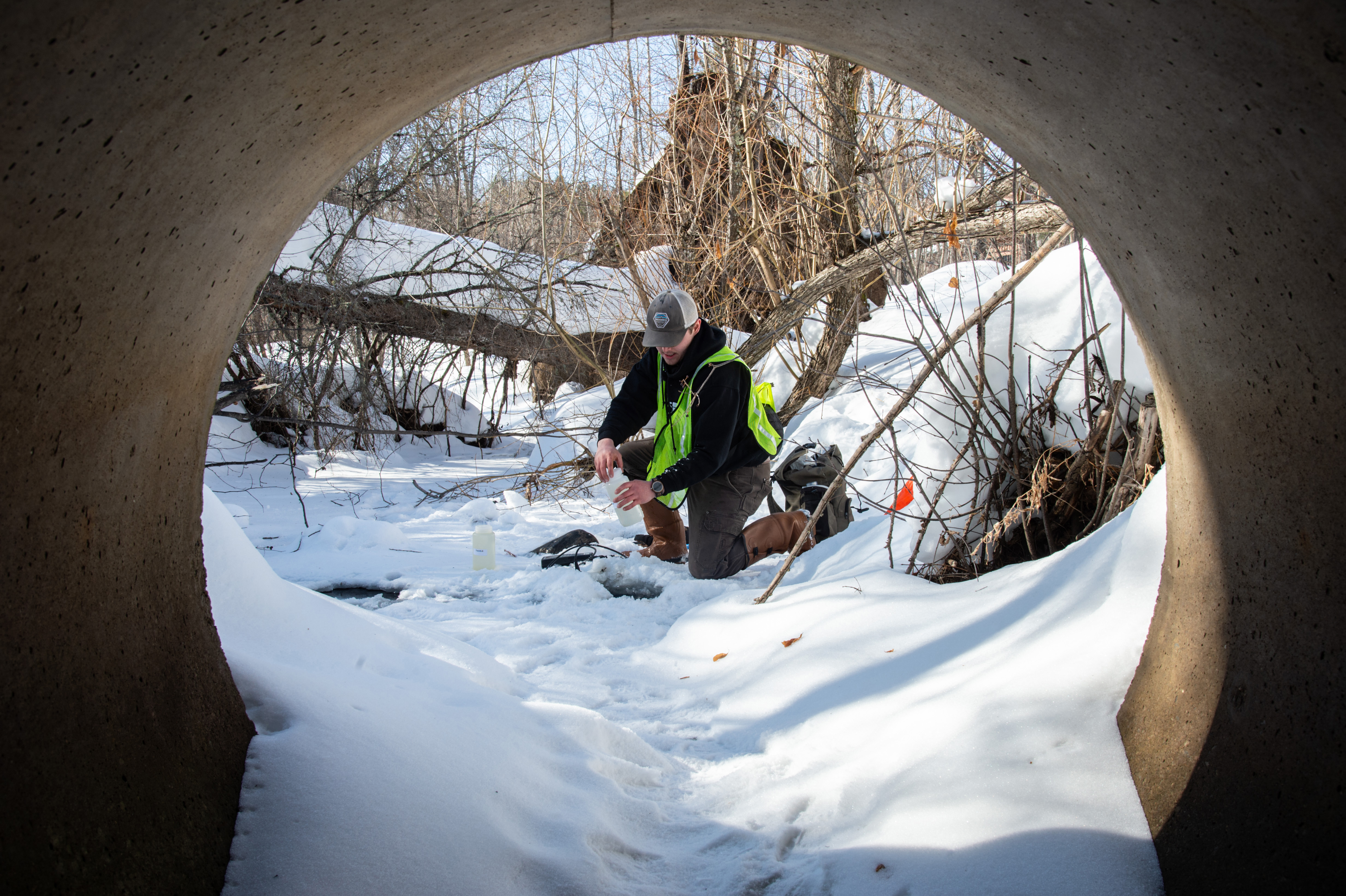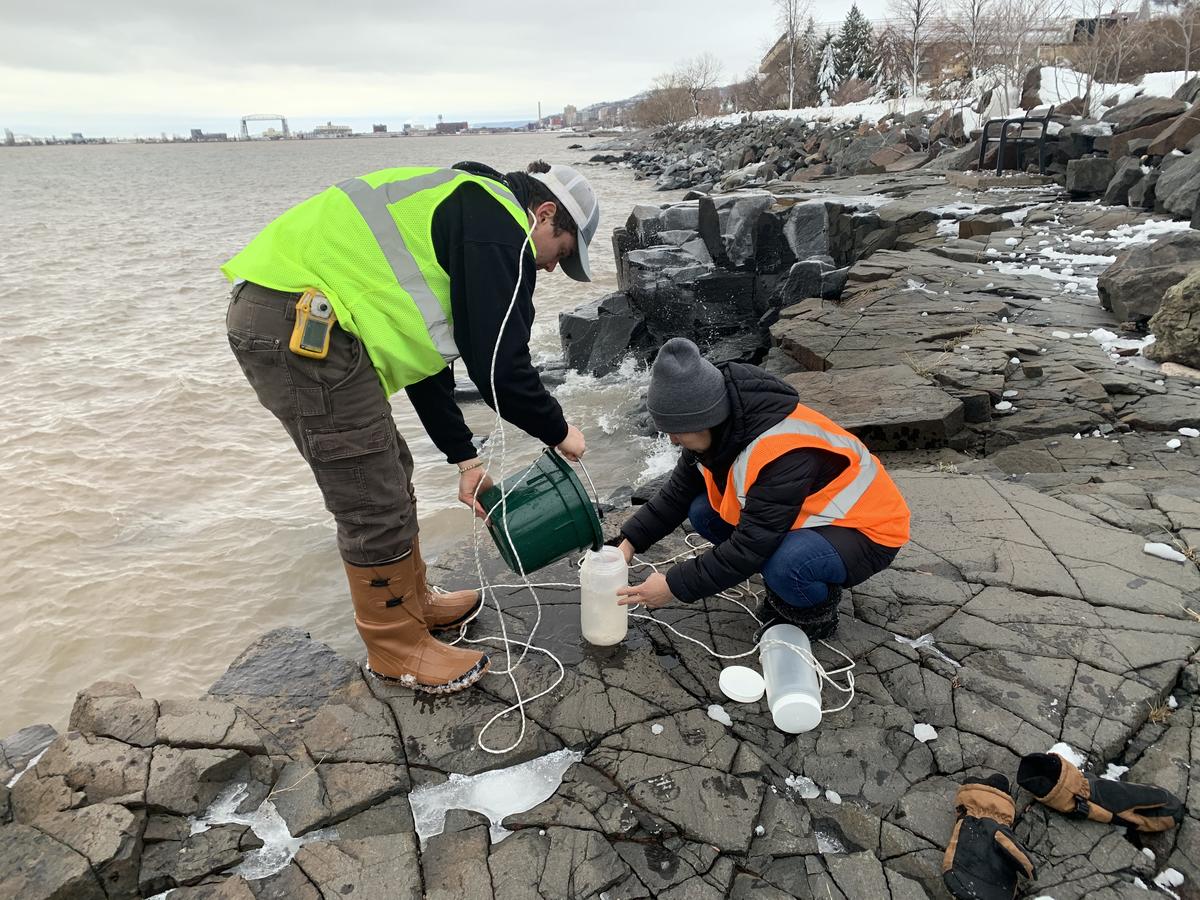Finding ways to keep drivers safe on snowy, icy winter roads has long been a goal of the Minnesota Department of Transportation. Minimizing the environmental impact is also a goal. NRRI research is helping in that effort.
Potassium acetate – a derivative of vinegar – is well known as a deicing chemical used to deice airplane wings. It works effectively in temperatures down to -15 °F and is not corrosive. Commonly used road salt stops being effective below 15-25 °F.
Also, it’s long been known that road salt – sodium chloride – on winter roads washes into freshwater resources and accumulates over time. It corrodes vehicles and other infrastructure and is toxic to wildlife. Seeking an alternative, MnDOT tested potassium acetate on roads and found that it worked well but needed to know if it has an environmental impact.
The field portion of the NRRI project, spanning the winters of 2020 through 2021, used automatic samplers to collect snowmelt runoff from a stretch of I-35 treated with potassium acetate near Lake Superior. The Blatnik and Bong Bridges connecting Duluth and Superior were also treated. Water samples were also collected directly from Lake Superior, which receives the traffic spray.
After each snow event, researchers grabbed shovels and braved the cold to collect the water for testing.
“The team effort was impressive,” said Chan Lan Chun, NRRI environmental engineer and co-principal investigator on the project. “They had to carefully watch the weather and be out in the cold for 5 – 6 hours at a time.”
Some Surprises
It was known that the organic acetate would degrade in water and the potassium would accumulate over time. What wasn’t known is its impact to plants and aquatic life. Tests done on the vegetation along the roadway showed that the acetate is toxic to plants while potassium is toxic to aquatic organisms, specifically water fleas.
The researchers also noted that the acetate didn’t deplete oxygen as they thought it would.
“Warm temperatures would make the acetate deplete oxygen as microbes

consume acetate quickly, but we didn’t see that in the cold winter temps,” said Chun. “Lake Superior also has a lot of wave action, which could aerate lake water, keeping dissolved oxygen high.”
Also surprising was how research protocols needed to adapt for the cold weather. Scientific water sampling is commonly done during the warm weather months. Chun’s team overcame many obstacles – snowbanks, dead batteries, frozen collection lines -- to conduct these winter studies. But they learned enough to share techniques in published papers for future winter field research.
Results Hit the Road
There is a role for potassium acetate to play for safe winter roads. Chun explained that in specific situations it could be a better choice than sodium chloride.
“We could use potassium acetate near Lake Superior as it is large waterbody and well mixed near shore, for instance,” she said. “But we need to use the right dose, not to exceed aquatic toxicity of potassium, and that needs more study.”
State agencies will use information from this and ongoing studies to develop a practical manual for winter road treatment that will outline a variety of ways to keep drivers safe while minimizing environmental impacts.
“Many other alternatives have been tested, like cheese brine and beet juice, but field evaluation studies are limited,” said Chun. “This project will help expand research for other alternatives to road salt.”
Grit Alternatives
A companion research effort is underway in the lab to identify locally sourced waste materials for grit alternatives to sand for winter roads. Taconite waste rock is showing promise for improving friction because of its angular nature and is a plentiful resource in northern Minnesota. Ground bark is a byproduct of the local wood products industry, and mineral deposits in the bark also contribute to its rough texture, making it an effective abrasive. Corn grit was also tested but found to be less effective, however it’s very absorbent and could possibly be brined before application.
“But even with alternative grits, we recommend that best practice management, like spring street sweeping and bioretention ponds, continue to keep these materials out of streams and lakes,” said Chun. Next steps for the grit research will be to test them in parking lots with real cars.
Another helpful outcome is a flowchart of methodologies, developed by the researchers, for testing road salt and grit alternatives, which hadn’t been previously established.
“Different areas of the country are trying to use local resources available to them. Now we can test those resources with more meaningful comparisons,” Chun added.
Salty streams?
Another research project which ended in 2021 was funded by the Minnesota Department of Natural Resources to monitor road salt impacts in Duluth streams. The researchers found that, obviously, salt in streams spiked during

the spring snow melt period, but surprisingly, salt concentrations showed up year-around.
“Seeing salt in the streams in the summer was very telling,” said Chun. “It means that the concentrations are accumulating over time.”
Research Partners
NRRI’s research effort is part of a broader collaboration to find solutions to this road safety and environmental conundrum.
Principal investigators on the potassium acetate study are John Gulliver at the University of Minnesota St. Anthony Falls Laboratory and Chris Rehmann at Iowa State University. The toxicity tests were conducted by NRRI and Great Lakes Toxicology and Ecology Division at the Environmental Protection Agency in Duluth.
The full report can be read and downloaded here: Environmental Impacts of Potassium Acetate as a Road Salt Alternative.
The alternative grit research is being led by Chun and her team with funding from the legislatively supported Environmental and Natural Resources Trust Fund. The stream research was funded by MnDOT’s Minnesota Lake Superior Coastal Program led by Chun as principal investigator.
The University of Minnesota’s Center for Transportation Studies published this research highlight: Potassium acetate more toxic than expected as road salt alternative.
